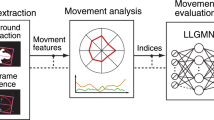Abstract
The purpose of this work was to develop a compact, noninvasive and objective tool for foetal movement monitoring and classification. Four tocodynamometers were used as movement transducers and their output signals processed by a minicomputer on which a microprocessor real time compatible algorithm was developed. The algorithm was based on time domain analysis where the parameters, such as averaging intervals and threshold levels were optimised in a trial and error procedure to minimise undetected foetal movements and false detections on a set of nine pregnant women. The detection score was 92·2 per cent when short foetal movements were ignored.
Similar content being viewed by others
References
Bonner, R. E. andSchwetman, H. D. (1968) Computer diagnostic of electrocardiograms: II. A computer program of ECG measurements.Comput. & Biomed. Res.,1, 366–386.
Inbar, G. F. (1979) Karhunen Loeve orthogonalization expansion for biological signal classification. XII International Conf. on MBE, Jerusalem.
Inbar, G. F. andNoujaim, A. (1984) Surface EMG spectral characterization and its application to diagnostic classification.IEEE Trans.,BME-31, 9, 597–604.
Markel, J. D. andGray, A. H. (1976)Linear prediction of speech. Springer Verlag.
Pearson, J. F. andWeaver, J. B. (1976) Foetal activity and foetal wellbeing: an evaluation.Br. Med. J.,1, 1305–1307.
Ron, M. andPolishuk, W. Z. (1976) The response of the foetal heart rate to amniocentesis.Br. J. Obstet. Gynecol.,83, 768–770.
Sadovsky, E. andPolishuk, W. Z. (1977) Foetal movements in utero: nature, assessment, prognostic value, timing of delivery.Obstet. and Gynecol.,50, 49–55.
Timor-Tritsch, I. E., Dierker, L. J., Zador, I., Hertz, R. H. andRosen, M. G. (1977) Classification of human foetal movement.Am. J. Obstet. Gynecol.,126, (1), 70–77.
Timor-Tritsch, I. E., Dierker, L. J., Hertz, R. H., Deagan, N. andRosen, M. G. (1978) Studies of antepartum behavioral states in the human foetus at term.Am. J. Obstet. Gynecol.,132, (5), 524–528.
Wennberg, A. andZetterberg, L. H. (1971) Application of a computer-based model for EEG analysis.Electroenceph. & Clin. Neurophysiol.,31, 457–468.
Author information
Authors and Affiliations
Rights and permissions
About this article
Cite this article
Florentin, I., Inbar, G.F. & Timor-Tritsch, I.E. Multichannel automatic foetal movement monitoring and classification system. Med. Biol. Eng. Comput. 23, 178–186 (1985). https://doi.org/10.1007/BF02456756
Received:
Accepted:
Issue Date:
DOI: https://doi.org/10.1007/BF02456756




